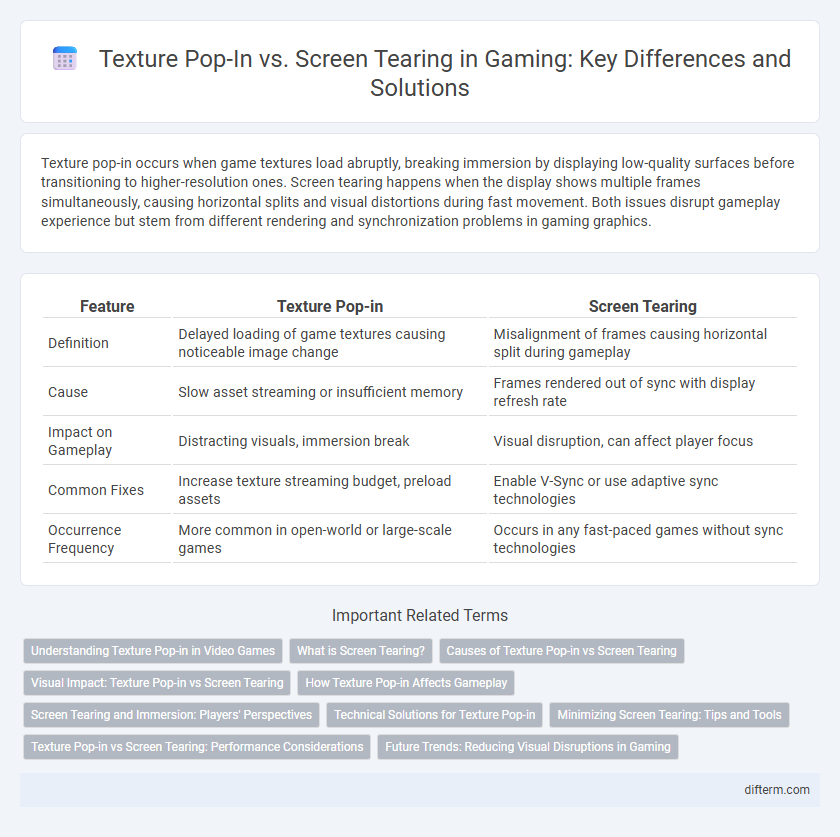Texture pop-in occurs when game textures load abruptly, breaking immersion by displaying low-quality surfaces before transitioning to higher-resolution ones. Screen tearing happens when the display shows multiple frames simultaneously, causing horizontal splits and visual distortions during fast movement. Both issues disrupt gameplay experience but stem from different rendering and synchronization problems in gaming graphics.
Table of Comparison
| Feature | Texture Pop-in | Screen Tearing |
|---|---|---|
| Definition | Delayed loading of game textures causing noticeable image change | Misalignment of frames causing horizontal split during gameplay |
| Cause | Slow asset streaming or insufficient memory | Frames rendered out of sync with display refresh rate |
| Impact on Gameplay | Distracting visuals, immersion break | Visual disruption, can affect player focus |
| Common Fixes | Increase texture streaming budget, preload assets | Enable V-Sync or use adaptive sync technologies |
| Occurrence Frequency | More common in open-world or large-scale games | Occurs in any fast-paced games without sync technologies |
Understanding Texture Pop-in in Video Games
Texture pop-in in video games occurs when high-resolution textures fail to load promptly, causing low-detail surfaces to appear temporarily on screen. This phenomenon is primarily caused by slow asset streaming or limited GPU memory, disrupting visual continuity and immersion. Unlike screen tearing, which results from mismatched frame rates and display refresh, texture pop-in specifically affects texture quality and loading times during gameplay.
What is Screen Tearing?
Screen tearing occurs when a video game's frame rate exceeds the display's refresh rate, causing multiple frames to be shown simultaneously and creating a disjointed image. This visual artifact disrupts gameplay immersion by splitting the screen into sections that display different points in time. Technologies like V-Sync and G-Sync are designed to synchronize frame rendering with the monitor's refresh cycle to eliminate screen tearing.
Causes of Texture Pop-in vs Screen Tearing
Texture pop-in occurs primarily due to slow texture streaming and insufficient memory bandwidth, causing delayed loading of high-resolution textures as the player moves through the game environment. Screen tearing results from the lack of synchronization between the GPU's frame rate output and the monitor's refresh rate, leading to partial frame updates displayed simultaneously. Both issues stem from hardware limitations but affect visual fidelity differently: pop-in impacts texture detail, while tearing disrupts frame cohesion.
Visual Impact: Texture Pop-in vs Screen Tearing
Texture pop-in disrupts immersion by abruptly loading low-resolution textures that suddenly appear as players approach, causing jarring visual inconsistencies. Screen tearing fractures the image by displaying mismatched frames simultaneously, creating horizontal splits and distracting motion artifacts during rapid camera movements. Both phenomena degrade gaming visuals, but texture pop-in affects asset detail localization while screen tearing distorts frame synchronization and fluidity.
How Texture Pop-in Affects Gameplay
Texture pop-in disrupts gameplay by causing sudden, noticeable appearances of low-resolution textures or missing objects as the game world loads, breaking immersion and hindering player navigation. This issue primarily stems from insufficient streaming speeds or hardware limitations, resulting in a lag between the game engine's asset loading and the player's current viewpoint. Unlike screen tearing, which affects visual synchronization, texture pop-in directly impacts environmental consistency and player experience by creating distracting visual anomalies.
Screen Tearing and Immersion: Players' Perspectives
Screen tearing occurs when the display shows information from multiple frames in a single screen draw, breaking immersion by creating distracting horizontal lines. Gamers often report that screen tearing disrupts gameplay fluidity, causing frustration and reducing overall engagement. Compared to texture pop-in, which affects visual quality momentarily, screen tearing directly impacts the player's experience by fragmenting the visual continuity essential for immersive gaming.
Technical Solutions for Texture Pop-in
Texture pop-in occurs when game assets fail to load promptly, causing visible abrupt texture changes, typically due to limited streaming bandwidth or insufficient memory management. Technical solutions for texture pop-in include implementing mipmapping techniques, optimizing texture streaming pipelines, and increasing prefetch buffers to ensure higher-priority assets load before they are rendered. Efficient use of level-of-detail (LOD) systems and asynchronous texture loading further minimizes latency, enhancing visual consistency without stressing GPU resources.
Minimizing Screen Tearing: Tips and Tools
Minimizing screen tearing in gaming requires enabling V-Sync or using adaptive sync technologies like G-Sync and FreeSync to synchronize the frame rate with the monitor's refresh rate. Lowering graphics settings and maintaining a stable frame rate above the monitor's refresh rate also reduces tearing significantly. Tools such as NVIDIA Control Panel and AMD Radeon Software offer customizable options to optimize performance and visual quality for smoother gameplay.
Texture Pop-in vs Screen Tearing: Performance Considerations
Texture pop-in occurs when game assets load too slowly, causing abrupt visual changes that disrupt immersion, while screen tearing results from mismatched frame output and display refresh rates, leading to horizontal visual artifacts. Texture pop-in primarily stresses storage bandwidth and memory streaming efficiency, whereas screen tearing emphasizes synchronization between the GPU and monitor refresh rate, often mitigated by technologies like V-Sync or G-Sync. Performance optimization must balance asset streaming speed to reduce texture pop-in and frame timing synchronization to minimize screen tearing, ensuring smooth and visually coherent gameplay.
Future Trends: Reducing Visual Disruptions in Gaming
Future trends in gaming focus on advanced rendering techniques such as variable rate shading and improved asynchronous compute shaders to minimize texture pop-in, while adaptive sync technologies like G-Sync and FreeSync aim to eliminate screen tearing. Emerging AI-driven upscaling and predictive frame rendering enhance seamless visual performance by preemptively loading textures and synchronizing frame outputs. These innovations collectively contribute to smoother, more immersive gaming experiences by drastically reducing visual disruptions.
Texture Pop-in vs Screen Tearing Infographic

 difterm.com
difterm.com